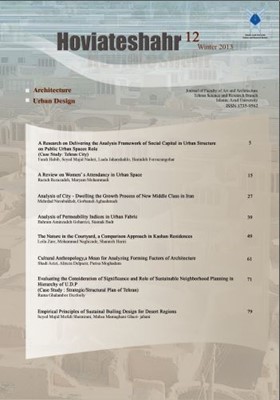Empirical Principles of Sustainable Building Design for Desert Regions
Subject Areas : architectureSeyed Majid Mofidi Shemirani 1 , Mahsa Mamaghani Gazi-Jahani 2
1 - School of Architecture and Urban Studies, University of Science and Technology, Tehran, Iran, 16844.
2 - Department of Art and Architecture, Islamic Azad University, Science and Research Branch, Tehran, Iran
Keywords:
Abstract :
Life thrives only in favourable environmental and climatic conditions. The ancient settlers discovered these conditions and they became factors, which affected the way they planned their buildings. Once these factors were clear and understood, then the principles were deduced and their designs were based upon them. For contemporary designers these principles, which were established on the basis of natural conditions and factors, and were supported by trial and error over thousands of years, could become significant decision-making constituents. Morphology, Density, Arrangement, Circulation, Roof Form, Surface, Openings, Shading Device and Material are preferred as the main topics for architectural principles and elements in different climates. The purpose is to identify strategies that would create more bioclimatically comfortable indoor spaces for the inhabitants, as they have been for many millennia. This paper will synopsize the results of a research on energy-conscious architectural elements and principles used throughout the history. The selected case studies were classified into historical eras regardless of their climatic or cultural diversity and were investigated by the date of construction, ranging from prehistoric to the current vernacular buildings, and they were cross-referenced and compared to each other. The three criteria that will define the entity of an urban centre are history, culture and climate. Each elements and principles according to its criteria is unique, however, many of their physical patterns are similar to each other, specifically patterns of elements and strategies influenced by the physical environment and climate. These criteria have been considered in order to include fairly representative examples of architecture from various historic periods, climatic zones and cultures, in other words, to have a homogeneous and balanced distribution of the selected buildings. The influence of climate on environmental and man's evolution, on one hand, has affected the evolution of architectural and urban form indirectly, and on the other hand, climate has affected the architectural morphology and configuration directly. In other words, indigenous and vernacular architecture is mainly born out of the climatic conditions. The followings are the main concluding notes: The empirical accomplishment of the past and what we scientifically know now about climatic design are similar and complement each other. The regional recommendations in the study confirm the similarities and contrasts of architectural elements and principles for habitable climatic zones. The concentration of major urban civilisations was mainly in the habitable climates throughout the world. However B and C type human inhabited climates were the first to see established urban centres, as these two climates provided a better environment for the development of architectural styles. The investigation of buildings in the same type of climate or geographical proximity but of different cultures suggests that the same pattern of architectural elements and strategies was developed, and that they were planned with similar configuration and design, and very similar forms and elements. Conversely, in many of the expansive and known civilisations around the world, although the same culture or even religion was practised, different architectural forms evolved or were implemented in different climates.
Cofaigh, E.O. (et al), (1996), "The Climatic Dwelling", James and James Ltd., London.
Fraser, D. and A. Sutcliffe (1983), "The Pursuit of Urban History" Edward Arnold Ltd., London.
Givoni, B. (1981), "Man, Climate, and Architecture", VNR, New York.
Givoni, B. (1998), "Climate Consideration in Building and Urban Design", VNR, New York.
Golany, G., (1983.), "Design for Arid Region", VNR, New York.
Hastings, R., and Wall (eds.), (2007), M., "Sustainable Solar Housing strategies and Solutions", Vol. 1, Earthscan, London, UK.
Jenks, M., & Dempsey, N., (2005), "Future Forms and Design for Sustainable Cities", Oxford: Architectural Press, Elsevier.
Knowles, R.L. (1978), "Solar Ethics - Urban Form" Proceedings of the 2nd National Passive Solar Conference, Vol. 3, US-ISES.
Knowles, R. L. (1980), "Energy and Form", The MIT Press, Cambridge, Mass.
Schantz, H. L., (1956), "History and Problems of Arid Land Development", op. cit.: in, White, G. H. (ed.), “The Future of Arid Land”, American Association for the Advancement of Science, No. 43.
Trewartha, G. T., (1968), "An Introduction to Climate", New York:.McGraw-Hill Book Co.
Watson, D. and Labs, K. (1983), "Climatic Design", McGraw-Hill, New York.
_||_

